R.J. Stowell's Blog: rjsomeone
April 18, 2022
Come on over...
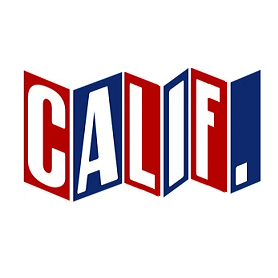
Many of you are dismayed at the lack of AM's posts of late. Don't be. Come and join us on FaceBook on the milesfromnowhere site. There you'll get a daily blast of rock history, insider's stories, and critiques about the music we love best. So, don't miss us, come see us at:
RJ Stowell is the author of Jay and the Americans, a fictional memoir, Miles From Nowhere, and its sequel, Calif. If you love rock 'n' roll, Woodstock, California, the Laurel Canyon scene, progressive rock, new wave, glam, you name it, you'll love our posts as much, MORE, than those you've read here over the years!
February 15, 2022
Kate Bush – The Dreaming – January – March 1982
 For The Dreaming, Kate Bush throws herself in headfirst, all batshit and piss, incorporating vocal loops, reverb, and a masterful use of new electronics, in an LP that is campy, romantic and emotive, yet inexplicably avant-garde. She's angry and pensive throughout the LP and typically poetic while pushing around the notions of our male-dominated world. It was here that Bush began to assume more diverse characters in her songs, as well, while utilizing the full range of her voice for dramatic effect. As one would expect from a novice in the producer's chair, there are moments of clutter and fluff, but for every misstep, there's a sense that Bush set out to make The Dreaming something more than she, or any other artist, had made before. The real reward, with this critical success/commercial failure, was how she was able to go so far towards the avant-garde and recover in better shape than before. Even in England, which treated her as a national treasure prior to the album's release, only one single ("Sat In Your Lap") cracked the top twenty. Why her label, after taking such a gamble, agreed to let Kate don the controls again for Hounds of Love is quite astonishing. The Dreaming shows a young woman, manic with ideas and creativity throwing caution to the wind and delivering an off-her-rocker theatrical and abstract masterpiece that very few artists have ever had the courage to make before or since.
For The Dreaming, Kate Bush throws herself in headfirst, all batshit and piss, incorporating vocal loops, reverb, and a masterful use of new electronics, in an LP that is campy, romantic and emotive, yet inexplicably avant-garde. She's angry and pensive throughout the LP and typically poetic while pushing around the notions of our male-dominated world. It was here that Bush began to assume more diverse characters in her songs, as well, while utilizing the full range of her voice for dramatic effect. As one would expect from a novice in the producer's chair, there are moments of clutter and fluff, but for every misstep, there's a sense that Bush set out to make The Dreaming something more than she, or any other artist, had made before. The real reward, with this critical success/commercial failure, was how she was able to go so far towards the avant-garde and recover in better shape than before. Even in England, which treated her as a national treasure prior to the album's release, only one single ("Sat In Your Lap") cracked the top twenty. Why her label, after taking such a gamble, agreed to let Kate don the controls again for Hounds of Love is quite astonishing. The Dreaming shows a young woman, manic with ideas and creativity throwing caution to the wind and delivering an off-her-rocker theatrical and abstract masterpiece that very few artists have ever had the courage to make before or since. Each track covers subjects from war ("Pull Out The Pin") to the protection of Aboriginal homelands ("The Dreaming"). Although The Dreaming hit No.3 on the UK charts, it was not a commercial success. "The Dreaming" (song) was a poor choice of single in July 1982. A superb track featuring Rolf Harris on didgeridoo and Kate singing in a quasi-Aus
sie accent ("Bang! goes another kanga on the bonnet of the van"), but simply not a song that would ever get much radio play (it peaked at No. 48). In fact, one of the problems with the album from a commercial point of view is that it contained nothing even resembling a commercial single. EMI, perhaps influenced by the success of "Sat In Your Lap" did not seem to pick up on it, and Kate was never asked to "come up with a hit" (a probable mandate for any other artist at the time). This lack of hits (the third and final single, "There Goes A Tenner," didn't even chart) is one of the reasons why the album is less well known. Conversely, it makes it much easier to listen to the album as a singular piece of work without a "Babookska" or a "Wuthering Heights." (Kate was canny enough to recognize this no-singles problem when it came to Hounds Of Love, on which she wore her commercial hat on side one (relatively speaking) and then tossed the hat in the fire for side two. "Running Up That Hill" creating the audience for The Ninth Wave and "Waking the Witch.") In the end, critics didn't really know what to make of The Dreaming. "Mixed" reviews is probably a good summary. "Overproduced" is the most common criticism. Generally speaking, it's come to be recognized as a significant work that many fans would include in their top Kate albums, jostling for the number one spot. True Gaffa fans will argue The Dreaming to their death. For this writer, it's among Kate’s best while certainly the least accessible, and frankly, it's just too sexy to talk about. The Dreaming is erotic art for the senses.
The album was recorded over an extended period from 1980 into 1981, with Kate stepping back from the project late in the year. She would return to the studio in January 1982 for the LP’s finishing touches and not complete the mixes until March.
February 8, 2022
Elton and Superstardom - Honky Chateau and Don't Shoot Me
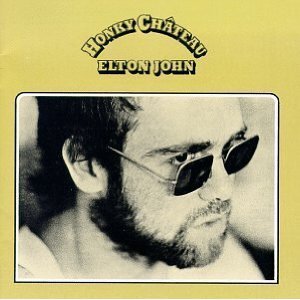 In 1972, Elton John scored his first number one album with Honky Chateau, recorded at the Chateau d'Hierouville. The album hit the top spot on the strength of its 2 hit singles, "Honky Cat" (with its instantly recognizable piano riff) and "Rocket Man," but the album goes far beyond to reveal the direction that Elton (and Bernie) would take. The lost innocence of the beautiful "Mona Lisas and Mad Hatters" is heartfelt; it's classic Taupin/John that found new life at The Concert For New York in October 2001. The rockers "Hercules" and "Amy" both pay tribute to the classic 50s rock Elton grew up on, while the steamy, slow and provocative "Slave" is Elton's emotionally-driven best. "Mellow" is another mid-tempo track, in Elton's trademark style, while "Suzie (Dramas)" is a cool, unnoticed gem. "I Think I'm Gonna Kill Myself," while a bit pedantic, is a look at Elton's dark side. The singer was undergoing pretty rocky times at the release of Honky Chateau and had struggled with depression throughout his early career, leading to experimentation with drugs, including Quaaludes and cocaine, which nearly killed him in 1990. The Gay Nineties styled music wonderfully offsets the depressive lyrics in the track. Bernie, as always, the unsung hero, capturing Reg at his most defenseless.
In 1972, Elton John scored his first number one album with Honky Chateau, recorded at the Chateau d'Hierouville. The album hit the top spot on the strength of its 2 hit singles, "Honky Cat" (with its instantly recognizable piano riff) and "Rocket Man," but the album goes far beyond to reveal the direction that Elton (and Bernie) would take. The lost innocence of the beautiful "Mona Lisas and Mad Hatters" is heartfelt; it's classic Taupin/John that found new life at The Concert For New York in October 2001. The rockers "Hercules" and "Amy" both pay tribute to the classic 50s rock Elton grew up on, while the steamy, slow and provocative "Slave" is Elton's emotionally-driven best. "Mellow" is another mid-tempo track, in Elton's trademark style, while "Suzie (Dramas)" is a cool, unnoticed gem. "I Think I'm Gonna Kill Myself," while a bit pedantic, is a look at Elton's dark side. The singer was undergoing pretty rocky times at the release of Honky Chateau and had struggled with depression throughout his early career, leading to experimentation with drugs, including Quaaludes and cocaine, which nearly killed him in 1990. The Gay Nineties styled music wonderfully offsets the depressive lyrics in the track. Bernie, as always, the unsung hero, capturing Reg at his most defenseless. The LP is the first to feature Nigel Olsson, Dee Murray and Davey Johnstone as full-time band members (the three had minor roles on Madman Across the Water). Honky Chateau's star tracks, "Rocket Man" and "Honky Cat" are out of the ordinary, good-time standards. The Mardi Gras atmosphere of "Honky Cat" superseded by the sci-fi prevalent in "Rocket Man," giving the track an unparalleled cool. The cold, pessimistic atmosphere of Honky Chateau retreats into a façade of instrumentally intriguing and playful ditties cloaked in Taupin's biting wit. It severs as Elton John's most Underrated LP.
The LP is the first to feature Nigel Olsson, Dee Murray and Davey Johnstone as full-time band members (the three had minor roles on Madman Across the Water). Honky Chateau's star tracks, "Rocket Man" and "Honky Cat" are out of the ordinary, good-time standards. The Mardi Gras atmosphere of "Honky Cat" superseded by the sci-fi prevalent in "Rocket Man," giving the track an unparalleled cool. The cold, pessimistic atmosphere of Honky Chateau retreats into a façade of instrumentally intriguing and playful ditties cloaked in Taupin's biting wit. It severs as Elton John's most Underrated LP.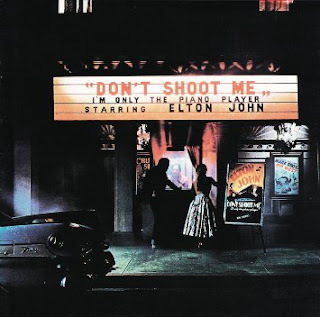 Don't Shoot Me I'm Only The Piano Player was released in 1973, and became Elton's second number one album heralding superstardom. The quote and album title has its origin in a meeting between Elton John and Groucho Marx. Marx gave Elton a hard time about his name, stating that he was really John Elton, to which Elton ultimately threw up his hands and said, “Don’t shoot me, I’m only the piano player.” Notice on the LP cover photo that a Marx Brothers movie poster appears in the theater marquee.
Don't Shoot Me I'm Only The Piano Player was released in 1973, and became Elton's second number one album heralding superstardom. The quote and album title has its origin in a meeting between Elton John and Groucho Marx. Marx gave Elton a hard time about his name, stating that he was really John Elton, to which Elton ultimately threw up his hands and said, “Don’t shoot me, I’m only the piano player.” Notice on the LP cover photo that a Marx Brothers movie poster appears in the theater marquee.While most will obtain the album for "Daniel" and "Crocodile Rock," "Texan Love Song," "Teacher I Need You" and "Midnight Creeper" are better still, showcasing Taupin’s kaleidoscopic allusions. "Have Mercy on the Criminal" is stunning, with a cool guitar intro by Davey Johnstone, then the newest recruit in the Elton John band, and a grandiose string arrangement by Paul Buckmaster. "High Flying Bird" is one of Taupin’s most beautiful and poignant lyrics, a Beach Boys tribute with soaring harmonies and an eerie majesty. My personal favorite, though, is the equally thoughtful and romantic "Blues For Baby and Me," which is everything an Elton John ballad should be: beautiful, ethereal, and powerful. Honky Chateauand Don’t Shoot Me are AM8s (Elton has more AM8s than any other artist).
January 29, 2022
Thick as a Brick - 1972
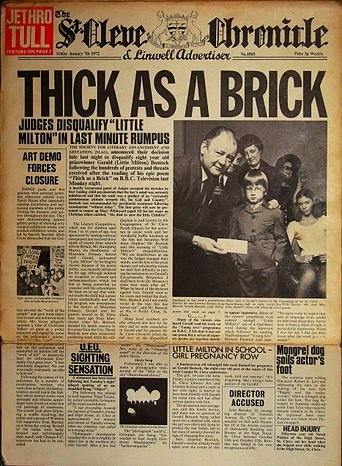 (Click Here to Read the St. Cleve Chronicle)In 1971, Jethro Tull had its biggest hit worldwide with the LP Aqualung that critics described as a concept album about religion, which Ian Anderson adamantly denied, indeed despised. Anderson decided to express his feelings about concept albums and prog-rock via parody, recording an album-length "song" called "Thick As A Brick," highlighting poetic passages that (as part of the album's concept) are put forth as the work of a precocious schoolboy who won a contest. Thick As A Brick has been slammed by haters as an example of the genre at its most excessive, while embraced by enthusiasts for the same reason. Few get the joke.
(Click Here to Read the St. Cleve Chronicle)In 1971, Jethro Tull had its biggest hit worldwide with the LP Aqualung that critics described as a concept album about religion, which Ian Anderson adamantly denied, indeed despised. Anderson decided to express his feelings about concept albums and prog-rock via parody, recording an album-length "song" called "Thick As A Brick," highlighting poetic passages that (as part of the album's concept) are put forth as the work of a precocious schoolboy who won a contest. Thick As A Brick has been slammed by haters as an example of the genre at its most excessive, while embraced by enthusiasts for the same reason. Few get the joke.The LP opens with a familiar three-minute passage that's less lumbering art-rock than folk-pop ditty. From there, the heaviness bullies its way in, yet it remains a single coherent song, not a suite or a medley. Though Anderson's word salad isn't meant to tell a story, the lyrics do cohere around a single theme, about how one shouldn't be quick to put his faith in pulp heroes or "wise men." It is, in many ways, a coming of age story. Whether campy parody or excessive self-aggrandizement, the music remains spry and fresh and retrospectively one of the most iconic pieces of the era.
The LP cover appears as a weekly, chatty small town newspaper carrying little world or national news. There are plenty of Briticisms not readily understood by American readers, and written in a manner similar to Monty Python, with irreverent references to penguins, stuffed or otherwise, and a "non-rabbit" occur often, and the crossword puzzle is wonderful. So is the connect-the-dots drawing called "Children's Corner." Here it is before filling it out:
 The St. Cleve Chronicle (dated Friday, January 7, 1972) features an article on prize winning adolescent poet Gerald (Little Milton) Bostock, his prize-winning poem and the scandal surrounding his disqualification on grounds that the boy is "seriously unbalanced" and the poem is "a product of an 'extremely unwholesome attitude towards life, his God, and country.'" Accompanying the front-page story is a photo in which Little Milton's 14-year-old girlfriend (Julia Fealey) can be seen in the background slightly lifting her shirt as she stares alluringly into the camera, her legs apart just enough to reveal her underpants.
The St. Cleve Chronicle (dated Friday, January 7, 1972) features an article on prize winning adolescent poet Gerald (Little Milton) Bostock, his prize-winning poem and the scandal surrounding his disqualification on grounds that the boy is "seriously unbalanced" and the poem is "a product of an 'extremely unwholesome attitude towards life, his God, and country.'" Accompanying the front-page story is a photo in which Little Milton's 14-year-old girlfriend (Julia Fealey) can be seen in the background slightly lifting her shirt as she stares alluringly into the camera, her legs apart just enough to reveal her underpants. 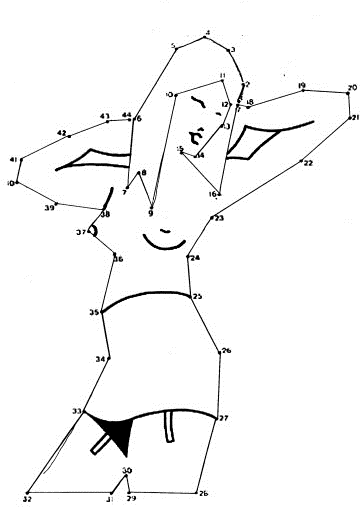 Ahh, That's Why
Ahh, That's WhyFluffy is SmilingThe St. Cleve Chronicle is densely packed with references that bear upon the lyrics to Thick as a Brick. Perhaps the most important to the basic theme of the "poem" is a small story on page 5 under the headline "Visiting Prof. Gives Talk." Here we learn that a certain Andrew Jorgensen tells his listeners that "man must learn to function as an independent observer of mass-behavior and develop the right of each individual to intellectual freedom on the particular level of which he is personally capable." The story goes on: "Unfortunately the lecture was terminated by flying bottles which hit Mr. Jorgensen below the left eye."
Considering the trouble and care lavished on this bogus community newspaper, it is curious that Anderson claimed that the album is not really a concept. Anderson's point seems to be that the lyrics provide a series of glimpses into the life of the average middle-class Englishman, dealing in turn with birth, youth (including sexual awakening), school, military service, and organized religion. Nonetheless, the song hangs together around a central theme, and indeed the elaborate sleeve design plays a crucial role in the way one understands the record. During an era in which album packaging seemed in many cases to have been as creative as the music inside (or at least as interesting), Tull set a new standard with Thick as a Brick.
January 24, 2022
The Story Goes - Part 10 - Choose Your Own Adventure
 Tomorrow, AM will repost the articles about the ten records every collector should have in his or her collection. The internet is a fickle thing. AM averages 1500 unique hits per day; then there will come a drought. We do something and Google gets pissed, or readers do, or maybe it's just fate, and we go through a week with 67 guests on average, with a 15 in the middle. It's all about the Google matrix or what gets posted or the time of the year.
Tomorrow, AM will repost the articles about the ten records every collector should have in his or her collection. The internet is a fickle thing. AM averages 1500 unique hits per day; then there will come a drought. We do something and Google gets pissed, or readers do, or maybe it's just fate, and we go through a week with 67 guests on average, with a 15 in the middle. It's all about the Google matrix or what gets posted or the time of the year. For the ten records posts, I think we cleverly found a way to address every collector's collection without choosing any specific LPs, bar one, Dark Side of the Moon - but based on that damned matrix, hardly anyone read it. Now that the arc is curving back our way, we'll repost, since, you know, the idea really was brilliant.
Our current series didn't play the same coy game but focused on AM's choices for the ten pinnacle moments in rock's classic era (let's call it '65 through '74, just for the sake of argument), with this exception: The Story Goes... FILL IN THE BLANK. For the 10th post in this series, the concept is your most important moment. Choose one and let us know.
This writer's is...

The Story Goes... In the mid-60s, Bowie met British rocker Vince Taylor who recorded the 1959 classic "Brand New Cadillac," later covered by the Clash. After too much LSD and an emotional breakdown (there's a unique rock story), Taylor joined a cult and decided that he was an alien god on Earth (hmm, that part's new).
Bowie was a teenage Mod fronting his band, The Lower Third, when he bumped into Vince Taylor at La Gioconda, a club in London. Taylor was an "American" rocker who was a major star in France, but by the time Bowie met him, Taylor was a washed-up acid casualty who had fried his brain after ingesting waaaaaay too much LSD. Born in Isleworth, England in 1939, the youngest of five children, his family emigrated to New Jersey when he was seven, where Taylor grew up on a diet of Elvis Presley, Jerry Lee Lewis, and Gene Vincent. When his sister Sheila dated Joseph Barbera — one half of animation team Hannah-Barbera; that's right, Jonny Quest, Flintstones, Peter Potamus — the family moved to California.
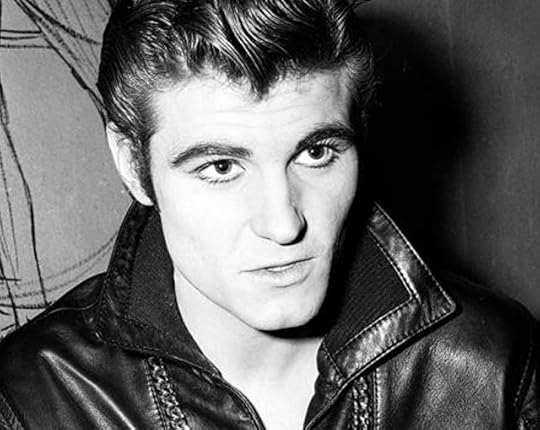 Like millions of other young American teenagers, Taylor wanted to be a rock 'n' roll idol. His singing was so-so but he could do a swell Elvis impersonation. Joe Barbera offered to manage him. When Barbera traveled to London on business—he took Taylor with him. This was when Brian Holden adopted the name "Vince Taylor." "Vince" from Elvis Presley's character "Vince Everett" in Jailhouse Rock; "Taylor" from actor Robert Taylor. After the release of his only real hit, Taylor discovered LSD. He liked it a lot. Depending on from whom you glean the info, after about a 1000 hits of acid came Taylor's Pauline conversion. He had a vision. He was not Vince Taylor but in fact, the son of Jesus Christ — Mateus Christ. After a few more tabs and a few more beatific visions — Taylor knew he was on a mission from God and set out to tell his fans who he really was.
Like millions of other young American teenagers, Taylor wanted to be a rock 'n' roll idol. His singing was so-so but he could do a swell Elvis impersonation. Joe Barbera offered to manage him. When Barbera traveled to London on business—he took Taylor with him. This was when Brian Holden adopted the name "Vince Taylor." "Vince" from Elvis Presley's character "Vince Everett" in Jailhouse Rock; "Taylor" from actor Robert Taylor. After the release of his only real hit, Taylor discovered LSD. He liked it a lot. Depending on from whom you glean the info, after about a 1000 hits of acid came Taylor's Pauline conversion. He had a vision. He was not Vince Taylor but in fact, the son of Jesus Christ — Mateus Christ. After a few more tabs and a few more beatific visions — Taylor knew he was on a mission from God and set out to tell his fans who he really was.A few nights later, Taylor said to his band (dialogue added by the writer): "All you ever think about is money. God is what you should be thinking about. I am the son of God's son. I am the new Messiah. Money is nothing. This is what I think of money." Taylor took a wad of cash out of pocket, pulled out a lighter and burned the money in front of his hungry, penniless band. It was Taylor's version of kicking the moneylenders out of the temple.
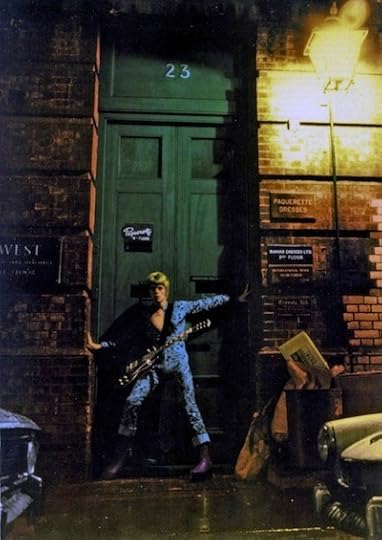 The next night, Taylor had a major gig. He turned up clean-shaven, done-up in makeup, black leathers, and a bike chain. The place was rocking. Taylor was in top form. Two numbers in, Taylor announced that he was the son of Christ. "I am Mateus," he said and sauntered off the stage and into the audience. He walked among the crowd. He blessed his followers. He gave them the Word of Mateus. "Come, follow me. I am the way." His sister Sheila was there. She freaked. Taylor told her to "Be calm. I have prepared a plane for you and my disciples. Come with me and I will fly you to my Father's kingdom in Heaven. God will make it so."
The next night, Taylor had a major gig. He turned up clean-shaven, done-up in makeup, black leathers, and a bike chain. The place was rocking. Taylor was in top form. Two numbers in, Taylor announced that he was the son of Christ. "I am Mateus," he said and sauntered off the stage and into the audience. He walked among the crowd. He blessed his followers. He gave them the Word of Mateus. "Come, follow me. I am the way." His sister Sheila was there. She freaked. Taylor told her to "Be calm. I have prepared a plane for you and my disciples. Come with me and I will fly you to my Father's kingdom in Heaven. God will make it so."Fast Forward to '72: Bowie's fascination with space travel and science fiction had already surfaced in "Space Oddity" "The Wild Eyed Boy From Freecloud" and "Life on Mars?" but he would soon be drawn toward something grander in scope. "Until that time," he later said, "the attitude was 'What you see is what you get.' It seemed interesting to try to devise something different, like a musical where the artist onstage plays a part."
It was then that Bowie met Taylor outside the Tottenham Court tube station. Taylor said he wanted to share some esoteric knowledge with the up and coming singer and unfolded a map of all the alien bases on Earth. "They're here amongst us." Bowie knelt beside Taylor on the sidewalk hunched over the map. Picture it.
 The Legendary Stardust CowboyFrom there, Bowie developed a character based on Taylor, as well as on other eccentrics like Texas "psychobilly" singer Legendary Stardust Cowboy and Japanese designer Kansai Yamamoto. "He always described how he'd take bits and pieces from all over the place, put them in a melting pot and they'd come out being him," said Bowie producer Ken Scott.Bowie dubbed this new creation "Ziggy Stardust" (first name taken from a tailor's shop that he saw from a train). As he fleshed out the concept further, Ziggy became an omnisexual alien rock star, sent to Earth as a messenger. Bowie's plot, loosely, was that humanity was in its final five years of existence, and Ziggy was dispatched to deliver a message of hope: He's a wild, hedonistic figure ("well-hung and snow-white tan"), but at his core communicates peace and love; he's the ultimate rock star. In the end, he's destroyed by his own excesses, and by his fans. There is indeed gobs of Vince Taylor there, a bit of Syd Barrett and a touch of Tommy, for that matter.
The Legendary Stardust CowboyFrom there, Bowie developed a character based on Taylor, as well as on other eccentrics like Texas "psychobilly" singer Legendary Stardust Cowboy and Japanese designer Kansai Yamamoto. "He always described how he'd take bits and pieces from all over the place, put them in a melting pot and they'd come out being him," said Bowie producer Ken Scott.Bowie dubbed this new creation "Ziggy Stardust" (first name taken from a tailor's shop that he saw from a train). As he fleshed out the concept further, Ziggy became an omnisexual alien rock star, sent to Earth as a messenger. Bowie's plot, loosely, was that humanity was in its final five years of existence, and Ziggy was dispatched to deliver a message of hope: He's a wild, hedonistic figure ("well-hung and snow-white tan"), but at his core communicates peace and love; he's the ultimate rock star. In the end, he's destroyed by his own excesses, and by his fans. There is indeed gobs of Vince Taylor there, a bit of Syd Barrett and a touch of Tommy, for that matter."Ziggy is advised in a dream by the infinites to write the coming of a starman ... this amazing spaceman who will be coming down to save the Earth," Bowie explained to William S. Burroughs in a Rolling Stone interview. "Ziggy starts to believe in all this himself and thinks himself a prophet of the future starmen. He takes himself up to the incredible spiritual heights and is kept alive by his disciples. When the infinites arrive, they take bits of Ziggy to make themselves real, because in their original state they are anti-matter and cannot exist on our world. And they tear him to pieces onstage during the song 'Rock 'n' Roll Suicide.'"
And so, what is my Story Goes moment? When Bowie met Taylor? The encounter certainly ties into the series, but no. Like you, my task is to choose my own adventure, and that I will share... tomorrow. In the meantime,
Give me your hand...
Ziggy Stardust - Another Shameless Plug for Jay and the Americans
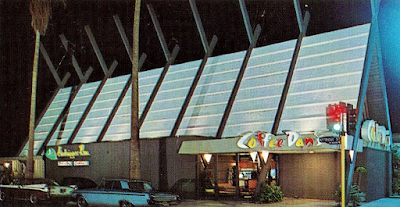 Max Ten had the house to himself; his parents, God knows where. "Paige was here, but she's gone out. Bring Gaia," but Gaia didn't answer, and I walked down Van Nuys Blvd. on a cool day in June. It was cruise night. I saw Driggers in his Super Bee with Laurie Heiser, so freakin' hot. They stopped by Coffee Dan's. I couldn't keep my eyes off her. "Come cruise with us, Jay. We're going to June Ellen's for donuts and then up to Mulholland."
Max Ten had the house to himself; his parents, God knows where. "Paige was here, but she's gone out. Bring Gaia," but Gaia didn't answer, and I walked down Van Nuys Blvd. on a cool day in June. It was cruise night. I saw Driggers in his Super Bee with Laurie Heiser, so freakin' hot. They stopped by Coffee Dan's. I couldn't keep my eyes off her. "Come cruise with us, Jay. We're going to June Ellen's for donuts and then up to Mulholland.""Can I make out with Heiser?" I looked at her. "Someday," I said and looked her in the eye with a grin.
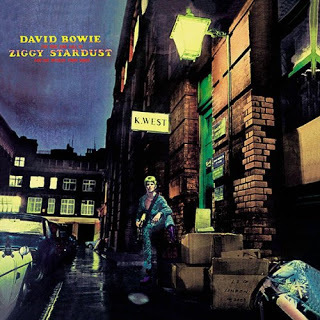 "K. I'll let Gaia know."
"K. I'll let Gaia know."He put the roof down and soared down Sylvan like a rocket. I crossed the street into Crane's Records by the Crocker Citizen Bank. In the window was Blue and Alice Cooper's School's Out. Honky Chateau was playing in the background. But I was after Ziggy. Max and I had gone mad over "Space Oddity," and I read in Creem about Ziggy. Bowie is an alien who manifests himself as a rock star to bring hope to a world that has just five years left. Max and I had read Clockwork and 1984 and We and Ziggy’s dystopian theme fit right in.
When Max Ten's parents were away last week, when he threw the big themed Mexican bash and we all dropped acid, we'd played like adults, using the good stereo in the living room, eating off the Fiesta Ware on the white sofa, but they'd be back in the morning and he'd cleaned and vacuumed and when I got there, they were in the garage. The garage was the kid's lair. His parents would throw parties and zip through cases of champagne and all the kids would be in the garage smoking pot. Paigeboy was an artist and she'd painted album covers on the doors of each of the cabinets. She'd painted Every Good Boy Deserves Favor and Teaser and the Firecat and Foxtrot. Sheets was there playing air drums; never missed a beat. Donna Miller was there, legs right up to her chin, which explained her beard (I always liked that joke). There was a pot haze in the room and Robert A. was suckin' on a bong. "Look." I pulled Ziggy out of the bag.
"Oh, man! We gotta get high first."
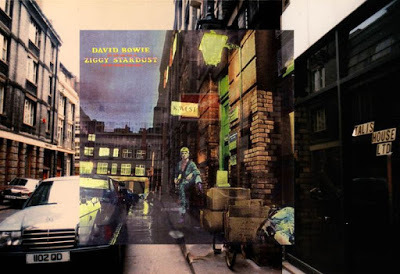 "Look, it says, 'TO BE PLAYED AT MAXIMUM VOLUME.'" Max was going through a lid of Colombian and then he reached into his pocket and said, "I forgot about this. Thai Stick." He took the bong from Robert A. and packed the Thai into it. It was the kind of high that you wanted to rip off your clothes and run down the street and yell, "I'm free," like Tommy (and freedom tastes of reality).
"Look, it says, 'TO BE PLAYED AT MAXIMUM VOLUME.'" Max was going through a lid of Colombian and then he reached into his pocket and said, "I forgot about this. Thai Stick." He took the bong from Robert A. and packed the Thai into it. It was the kind of high that you wanted to rip off your clothes and run down the street and yell, "I'm free," like Tommy (and freedom tastes of reality).And oh, fuckin' A, "Five Years." The melancholy. Bowie, I mean Ziggy, yelling at us and then he screams, "So many people." I sat next to Max and Ziggy sang "I kiss you, you're beautiful, I want you to walk," and it was my imagination or his contact lenses, but Max had a rookerful of tears in his glazzies; Horrorshow, oh my brothers. "Soul Love" funked its way to "Moonage Daydream" without pause. "I'm a space invader," and then it was all Mick Ronson and so beautiful, and "Starman" too, and it felt a bit sad until those hopeful la la la's that make you want to smile. Jay and the Americans is available all over the world!
Like these snippets? Get the novel now!
CreateSpace - Amazon - Amazon UK - Amazon France - Amazon Russia
January 21, 2022
If I Could Only... I Forget - Part 1
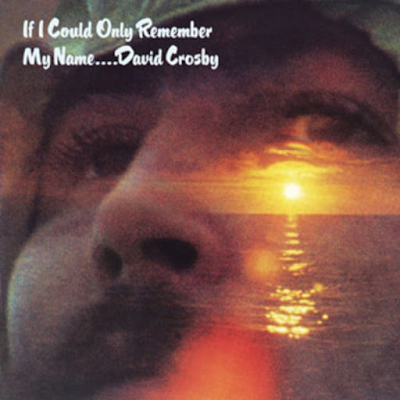 I met David Crosby when I was 7 years old. I didn't know who he was, but I liked his mustache. Here's an excerpt from my memoir, Jay and the Americans:
I met David Crosby when I was 7 years old. I didn't know who he was, but I liked his mustache. Here's an excerpt from my memoir, Jay and the Americans: More than once we went to the Trip. Laura and I weren’t allowed in, 21 and up, so we'd sit in the back and listen and I’d color and Laura and I would play Ouija. I liked the Ouija. It pointed to the moon a lot. It spelled my name. David Crosby played with us. I didn’t really know who he was, but I liked him because he looked like a walrus. He asked a question and it pointed to the no. That’s when he colored with me. I don't think he liked the Ouija's answer, but he colored real nice.
The Trip was a former jazz club on the Sunset Strip next to the Playboy Club. We were there a lot at one point and, as always, I carried with me a Disneyland coloring book. Another artist who colored with me was Marianne Faithful. I had a crush on her, but she colored out of the lines.
Ouija with the walrus was around 1967 or '68, Crosby was still with the Byrds. He left or was fired from the band and met Graham Nash and Stephen Stills at Mama Cass's house and from there produced Joni Mitchell's debut. In May 1969 came the trio's debut, their incredible performance with Neil Young at Woodstock, and Déjà vu in 1970. In February 1971 came Crosby's solo LP, If I Could Only Remember My Name. Recorded at Wally Heider in San Francisco and at A&M in Hollywood, the LP featured a myriad of prominent musicians, Graham Nash, Gerry Garcia, Paul Kantner, Jorma Kaukonen, Grace Slick, and Phil Lesh, among others. An impromptu band name was applied to the troupe, The Planet Eart Rock 'n' Roll Orchestra. The band would appear on other recordings as well including Graham Nash's Songs For Beginners.
From the opening track, the mantra-like "Music Is Love," it is apparent that the session was a lesson in soul-cleansing for Crosby who was mourning the tragic death of his girlfriend, Christine Hinton. But instead of going down the 'primal scream' route that Lennon chose, David decided to pour out his grief in a series of sometimes wordless jazzy songs.
"Tamalpais High (At About 3)" is a good example of the wordless approach he took on several of the tracks. Over a moody backing, David exorcises his pain with ghostly harmonies. The brief closer "I'd Swear There Was Somebody Here" is even more stripped-down with just his voice floating serenely skyward.
An atmospheric album, Side A has more of a CSNY sound than any other solo effort by C, S, N, or Y, partly because N & Y are present, indeed, "Cowboy Movie” would be right at home on "Déjà vu." Side B tends toward what could be called ambient music and risks disappearing altogether in a smoky haze, but it's quite pleasant, especially "Song With No Words." As an ambient music fan, I'm drawn toward "I'd Swear There Was Somebody Here." Crosby? Sounds like Eno.
As a window into a time and a mindset, "If I Could Only Remember My Name" is soaked with folky, Laurel Canyon ambiance. As you might expect, there is an L.A. druggie feel to it and therein lies the mood, a journey that started well but slowly goes bad. Retrospectively, one can hear the dream of the 60's die a bit on this album, and its participants aren't even aware.
January 14, 2022
The Six Wives of Henry VIII
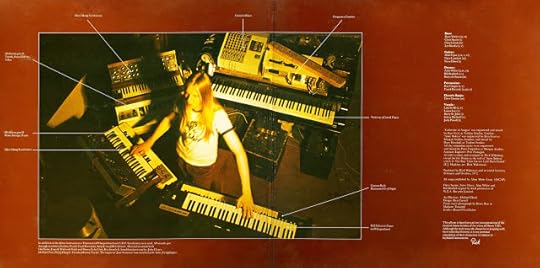 Cat Stevens’ “Morning Has Broken” is an amalgam of this and that. The lyrics from a children’s hymnbook by Eleanor Farjeon, the tune from the Scottish traditional folksong, “Bunessan,” the piano theme a variation of Rick Wakeman’s “Catherine Howard.” The recording of the track was a bit of a distraction from Wakeman’s first solo project, The Six Wives of Henry VIII, and his session work. The Stevens’ track, recorded in March 1971, was Wakeman’s last session gig before joining Yes for the recording of Fragile in August and Bowie for the recording of Hunky-Dory.
Cat Stevens’ “Morning Has Broken” is an amalgam of this and that. The lyrics from a children’s hymnbook by Eleanor Farjeon, the tune from the Scottish traditional folksong, “Bunessan,” the piano theme a variation of Rick Wakeman’s “Catherine Howard.” The recording of the track was a bit of a distraction from Wakeman’s first solo project, The Six Wives of Henry VIII, and his session work. The Stevens’ track, recorded in March 1971, was Wakeman’s last session gig before joining Yes for the recording of Fragile in August and Bowie for the recording of Hunky-Dory. A year earlier, still recording with Strawbs, Wakeman’s manager received a call from Jerry Moss, the M in A&M. “So we went down to the A&M lot, which was Charlie Chaplin’s old film studios. I hadn’t really ever sat in an executive’s office before, so they asked me if I wanted some coffee and I said 'I’d rather have a Scotch' – this was back in my drinking days and it was only nine in the morning.
“Anyway, Moss showed us ‘round the lot and it was fantastic. And then he said that they had an option on me because of the Strawbs thing. He said, ‘Word in the business is that Yes is going to be a very big band. If that’s so then we should probably put out a solo album”. I’d never really thought about it before, but it sounded like Christmas, so I said 'Yes please.'”
While maligned by critics (not all of them, but), The Six Wives of Henry VIII sold more than half a million copies in the U.S. upon its release (14 million copies to date). Inspired by a biography of Henry VIII that Wakeman bought at the airport, the concept provided a convenient framing device for a series of melodies he’d been toying with. Gathering together a formidable ensemble of bandmates from Yes (all but Anderson) and Strawbs, Wakeman fashioned his compositions into distinct themes and timbres not unlike those created by John Williams for Star Wars.
The Six Wives’ gatefold sleeve displayed the impressive array of instruments that Wakeman had at his disposal, and while “Jane Seymour” represents the album’s most faithful Tudor interlude, utilizing the church organ from St. Giles Cripplegate, “Anne Boleyn” is heaven on earth for aficionados of early monophonic Minimoog and ARP synths. The two standout tracks, though, are “Catherine Of Aragon” and “Catherine Parr,” the latter including a memorable Hammond C3 section of immaculately controlled arpeggios punctuated by Bill Bruford’s formidably inspired drumming.
December 20, 2021
Rick Wakeman, Session Man
 Rick Wakeman is one of rock's foremost keyboardists. Obviously any Yesfan looks upon Wakeman as one of the core musicians in the band's storied half-century, but fewer realize that, aside from his initial band, Strawbs, Wakeman was a key incidental session player, most famously for David Bowie's "Life on Mars"; the song would lose its luster without that iconic piano. For Bowie, Wakeman also contributed to Space Oddity, playing the mellotron and electric harpsicord, Elton John's Madman Across the Water, Cat Steven's Teaser and the Firecat, the piano for T-Rex's "Bang a Gong" and Lou Reed's debut LP.
Rick Wakeman is one of rock's foremost keyboardists. Obviously any Yesfan looks upon Wakeman as one of the core musicians in the band's storied half-century, but fewer realize that, aside from his initial band, Strawbs, Wakeman was a key incidental session player, most famously for David Bowie's "Life on Mars"; the song would lose its luster without that iconic piano. For Bowie, Wakeman also contributed to Space Oddity, playing the mellotron and electric harpsicord, Elton John's Madman Across the Water, Cat Steven's Teaser and the Firecat, the piano for T-Rex's "Bang a Gong" and Lou Reed's debut LP.Classically trained at the Royal College of Music, Wakeman found himself in such high demand as a session player that he dropped out of the College in 1969 to concentrate on his career. Wakeman recalls the mellotron session for "Space Oddity:" It was early 1969; I was 19 coming up on 20. I'd worked with the producer Tony Visconti that year on the Junior's Eyes album. I was playing a Mellotron, which was a relatively new instrument and difficult to keep in tune, but I'd found a crafty way. Tony asked: 'How'd you do that?' and I said: 'It's just a fingering technique' and that was that.
"Soon after, Tony called me up and said, 'Rick, I need you to come up to London to play some Mellotron on David Bowie's new single, "Space Oddity." I drove up to London and parked on Wardour Street and went over to Trident Studios to meet David. 'Tony says you can keep this bloody thing in tune,' he said. 'Well yeah, hopefully,' I replied. It was before David was famous, so I wasn't nervous about meeting him – it was just another bit of session work.
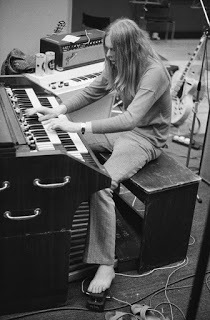 "We knocked it out in about 20 minutes. I think it got to number five first time around in '69 and then in '75 when it was rereleased it went to number one. A year later David called and asked me if I'd play some piano on some new songs. So I went round to his house in Beckenham, Kent. I nicknamed it Beckenham Palace because at the time I was living in a tiny little terraced house in West Harrow and his kitchen was bigger than my entire place.
"We knocked it out in about 20 minutes. I think it got to number five first time around in '69 and then in '75 when it was rereleased it went to number one. A year later David called and asked me if I'd play some piano on some new songs. So I went round to his house in Beckenham, Kent. I nicknamed it Beckenham Palace because at the time I was living in a tiny little terraced house in West Harrow and his kitchen was bigger than my entire place."I sat at the piano while he played songs on his battered old guitar. Things had really changed for him. He was a successful artist and he had a young family. I sat at the piano while he played a load of songs to me on his battered old 12-string guitar. "Life on Mars" stuck out as being something very special. He wanted a piano solo, he wanted the album to be very piano-orientated. I was given complete freedom by him."
In 1971, having just joined the band, Yes was on tour for Fragile, interestingly as the opening band for Black Sabbath. "Yes supported Black Sabbath in America in the early days, and me and Ozzy always got on great. Because of my various alcoholic diseases, I haven't been able to drink for 20-odd years, but back then I was a serious drinker, as were all of Sabbath, so we got on like a house on fire, matching each other drink for drink. When we supported 'em on Yes’s Fragile tour, they had a spare seat on their private plane, so a lot of the time I'd travel with them. You literally couldn't move for booze on that plane. Ozzy was probably putting away as much as me – which was as much as humanly possible."
In the book, Caped Crusader, Rick Wakeman in the 1970s, Elton John writes in the book's foreward, "Rick's mastery of electronic instruments only adds to his abilities, and I think it is fair to say he was one of the reasons I stuck to the piano. I also admire his attitude to stage shows - always willing to take a gamble, but never sacrificing his musical ideals. Just as important, never losing his sense of humour and his sense of the ridiculous. Anyone who can put on an ice show at Wembley must be all right. I must add that Rick loves cars and is a fanatic when it comes to soccer. Therefore, he and I have an unbreakable bond.
"It has become fashionable to knock musicians who have been around a while, and who are still determined to persevere in what they believe in. It is very easy to be misunderstood along the way, but it is vital to ignore trends and get on with what you want to do. Rick will always do this because, quite simply, he's that much better than everyone else."
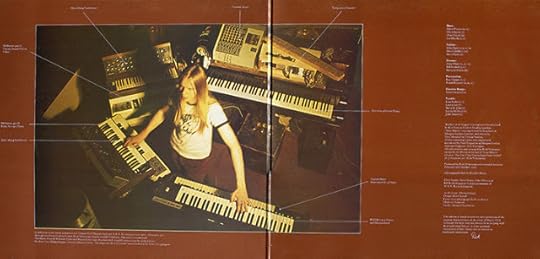
The photo above is from the gatefold of The Six Wives of Henry VIII and shows the variety of keyboards that Wakeman has used. Starting on the upper left is Wakeman's confessed favorite, the Mini Moog. Clockwise you'll note a custom mixer and a frequency counter sitting on a Steinway Grand Piano. Rick's left hand is playing the RMI electric piano, which sits atop a custom Hammond C3. With his right hand he plays another Mini Moog that sits upon a Mellotron 400D.
December 17, 2021
Funny. Write a biography and people question how much of ...
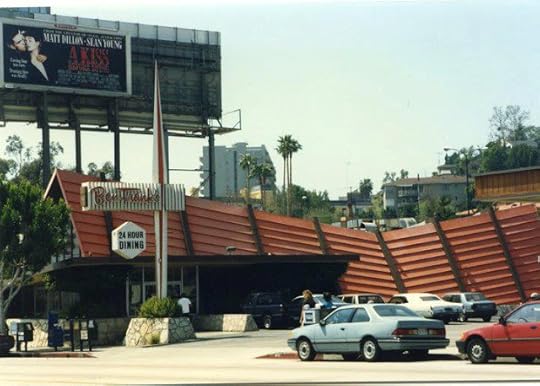
Funny. Write a biography and people question how much of it is fiction. Write a novel and everyone wants to know what parts are real. You can’t win. I’ve often written about living on the fringe as a writer, about knowing people superficially, but, as well, I've had my share of close encounters. This one, I included in my fictional memoir, Jay and the Americans (Amazon): —I saw Rickie Lee Jones at the Roxy. Tom Waits was in the audience, drunk. So was Chuck E. Weiss. Rickie, too, was drunk as a skunk, but the songs were funky, and if not they were beautiful. The show was over, the crowd dispersed. The curtain was drawn when Rickie pushed her way through. She said, “Where’s my hat? Where’s my fucking beret?” I was sitting at a table taking notes. She looked at me. “Jou take my hat? Hey, hey, where’s my fucking hat?” Tom Waits came out from behind the curtain. In his gruff voice, he said, “You seen the lady’s hat?” I looked around. A beret was on the table next to mine. I handed it to her. She said, “Well, thanks, then. I though’ you stole my hat.”— After that, they knew me; or they knew of me. But early one morning, the sun peeking over the horizon, I got to talk with Rickie Lee. I wasn’t a Duke’s fan; Ben Frank’s was cleaner, better food, off-street parking. I shuffled in alone after a long night at the Roxy and the Rainbow; Max Ten and my friends had all gone home. Rickie was there with Waits in the back table, what was rightfully “our” booth, btw, though by then, she had a Grammy nomination and my claim to the real estate was null and void. Maybe Duke’s was no longer worthy.I bumped into the waitress and knocked the checkbook out of her hand. I picked it up, and as I handed it back she said, “Sitting here?” I looked at Rickie Lee. She shrugged and moved over. Waits was across the table, a porkpie hat over his face, his legs stretched out into the aisle.“Where’s your friends?”“Duke’s, maybe. Home.”“What’s your friend’s name, anyway? See him everywhere.”“Max Ten. Maxwell Tenniel.” To the waitress, I said, “Pancake sandwich.”“Coffee?” I nodded.“I like that. You know, nicknames and shit.”“I noticed. ‘Sal lives in a black vinyl pen.’”“In New Jersey. Sal Bernardi. Have you met him?”I shook my head. “Your songs are colorful, like the people in them.”“Everybody real. Friends.” The waitress brought my breakfast and filled my coffee. Rickie said, “I know you, right?”“You thought I stole your beret.”“When?”“At the Roxy.”Waits took the hat from his face. “I remember you.” He licked his lips and put the hat back over his eyes.“I used to live in Venice, you know? You don’t remember. You guys wouldn’t, you know, PLP with me*”She laughed. “When was that?”“Couple years.” I sipped my coffee. Then it was the journalist in me. “So, new album?”“Working on it. Maybe I’ll borrow Max Ten.”“Kinda wish you wouldn’t. What, you need more characters. Who you got?”“Johnny the King. Eddie with the Crazy Eye. Cunt-Finger Louie.”“Nice.”“That one’s Sal’s. So, you using Max Ten? You writin’ a book?”“Kinda.”Waits sat up. He said, “Don’t ‘kinda’ write a book.” I can hear him in my mind.Rickie looked at me and shrugged. She said, “Write a book.”And there you have it, my impetus for my first novel. Thanks, Rickie.*Not sure if PLP is a Rickie-ism or not. It means Public Leaning Post. Like a parking meter or the lamppost; an old friend you can lean on.



